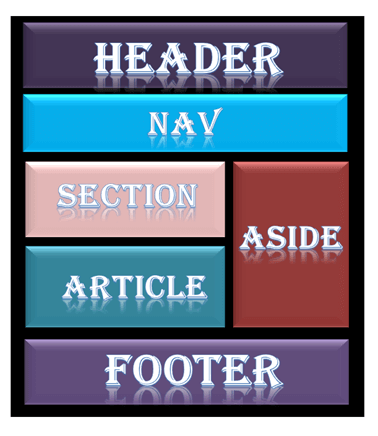HTML 布局提供了一种以礼貌、结构良好和响应式形式排列网页的方法,或者我们可以说 HTML 布局指定了一种排列网页的方式。网页布局与 HTML 文档的可视元素的排列一起工作。
网页布局是创建网站时要牢记的最重要的部分,这样我们的网站才能显得专业且美观。您还可以使用基于 CSS 和 JAVASCRIPT 的框架为响应式和动态网站设计创建布局。

每个网站都有特定的布局,以特定方式显示内容。
以下是用于定义网页不同部分的不同 HTML5 元素。
<header>:用于定义文档或节的标题。
<nav>:用于定义导航链接的容器
<section>:用于定义文档中的一个section
<article>:用于定义独立的自包含文章
<aside>:用于定义内容之外的内容(如侧边栏)
<footer>:用于定义文档或节的页脚
<details>:用于定义附加细节
<summary>:用于定义 <details> 元素的标题
<header> 元素用于创建网页的标题部分。标题包含介绍性内容、标题元素、网页的徽标或图标以及作者信息。
<!DOCTYPE html> <html> <head> <title>First Webpage</title> </head> <body> <header style="background-color: #303030; height: 80px;width: 100%"> <h1 style="font-size: 30px; color: white;text-align: center; padding-top: 15px;">Welcome to MyFirstWebpage</h1> </header> </body> </html>
<nav> 元素是导航链接主块的容器。它可以包含同一页面或其他页面的链接。
<!DOCTYPE html>
<html>
<head>
<style>
li{ display: inline-block;
padding: 10px}
</style>
</head>
<body>
<nav style="background-color:#bcdeef;">
<h1 style="text-align: center;">Navgation Links</h1>
<ul>
<li><a href="#">link1</a></li>
<li><a href="#">link2</a></li>
<li><a href="#">link3</a></li>
<li><a href="#">link4</a></li>
</ul>
</nav>
</body>
</html>HTML <section> 元素代表网页的一个单独部分,其中包含组合在一起的相关元素。它可以包含:文本、图像、表格、视频等。
<!DOCTYPE html> <html> <head> <title>Page Section</title> </head> <body> <section style="background-color:#ff7f50; width: 100%; border: 1px solid black;"> <h2>Introduction to HTML</h2> <p>HTML is a markup language which is used for creating attractive web pages with the help of styling, and which looks in a nice format on a web browser.</p> </section> </body> </html>
HTML
<!DOCTYPE html> <html> <head> <title>Article Example</title> </head> <body> <article style="width: 100%; border:2px solid black; background-color: #fff0f5;"> <h2>History of Computer</h2> <p>Write your content here for the history of computer</p> </article> </body> </html>
HTML <aside> 定义与主要内容相关的旁白内容。<aside> 内容必须与主要内容相关。它可以作为网页主要内容的侧边栏。
<!DOCTYPE html> <html> <head> <title>Aside Example</title> </head> <body> <aside style="background-color:#e6e6fa"> <h2>Sidebar information</h2> <p>This conatins information which will represent like a side bar for a webpage</p> </aside> </body> </html>
HTML <footer> 元素定义该文档或网页的页脚。它主要包含有关作者、版权、其他链接等的信息。
<!DOCTYPE html> <html> <head> <title>Footer Section</title> </head> <body> <footer style="background-color:#f0f8ff; width: 100%; text-align: center;"> <h3>Footer Example</h3> <p>© Copyright 2018-2020. </p> </footer> </body> </html>
HTML <details> 元素用于添加有关网页的额外详细信息,使用可以根据需要隐藏或显示详细信息。
<!DOCTYPE html> <html> <head> <title>Deatils element</title> </head> <body> <details style="background-color: #f5deb3"> <summary>This is visible section: click to show other details</summary> <p>This section only shows if user want to see it. </p> </details> </body> </html>
HTML <summary> 元素与网页中的 <details> 元素一起使用。它用作摘要,关于 <details> 元素内容的标题。
<!DOCTYPE html> <html> <head> <title>Summary Example</title> </head> <body> <details> <summary>HTML is acronym for?</summary> <p style="color: blue; font-size: 20px;">Hypertext Markup Language</p> </details> </body> </html>